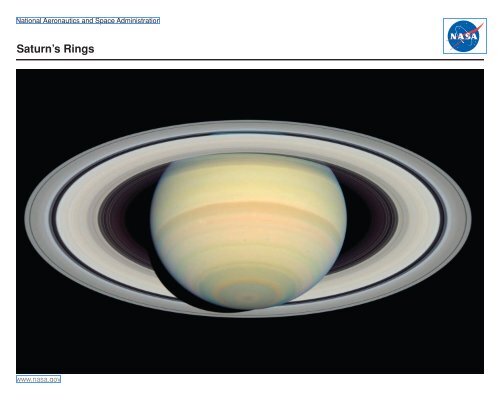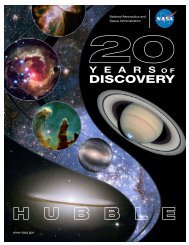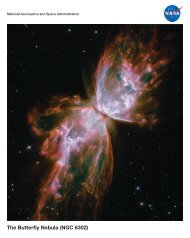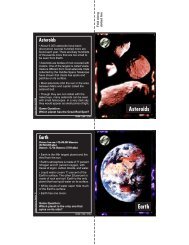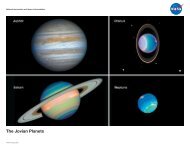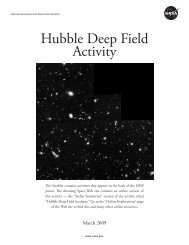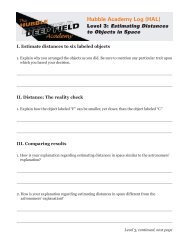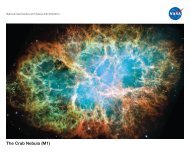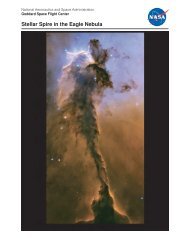Lithograph: Saturn's Rings (PDF) - Amazing Space - STScI
Lithograph: Saturn's Rings (PDF) - Amazing Space - STScI
Lithograph: Saturn's Rings (PDF) - Amazing Space - STScI
- No tags were found...
You also want an ePaper? Increase the reach of your titles
YUMPU automatically turns print PDFs into web optimized ePapers that Google loves.
National Aeronautics and <strong>Space</strong> AdministrationSaturn’s <strong>Rings</strong>www.nasa.gov
National Aeronautics and <strong>Space</strong> AdministrationGoddard <strong>Space</strong> Flight CenterSaturn’s <strong>Rings</strong>The Mystery of the <strong>Rings</strong>In 1610, Galileo pointed the newly invented telescope at Saturn and noticed strangeshapes on both sides of the planet. Galileo thought the shapes were two moons, oneon each side of the planet. The “moons” seemed to play “hide-and-seek” with him, appearingand disappearing over several years of observations.Many other astronomers studied Saturn’s strange and changing appearance forseveral decades without finding a good explanation. Dutch astronomer ChristiaanHuygens solved the mystery in the 1650s. In his book, Huygens described Saturnas being “surrounded by a thin flat ring.” Although Huygens’ explanation of Saturn’sfamous rings was not entirely correct, it forms the foundation for today’s theories ofthe ring system.After hundreds of years, astronomers are still studying Saturn, the sixth planet fromthe Sun, and its signature rings. Other planets have rings, but they are so faint thatwe cannot easily see them. Saturn’s rings stand out because they are very bright andcontain lots of icy material that reflects sunlight.Saturn and its ring system have been visited over the past 30 years by several spacecraft,including Pioneer 11 and Voyagers 1 and 2. <strong>Space</strong>craft, however, cannot land onthe ringed planet. Saturn, like Jupiter, is a gas giant and does not have a solid surface.Since its launch in 1990, the Earth-orbiting Hubble <strong>Space</strong> Telescope also has beenprobing the planet.Observations by Hubble, other spacecraft, and many ground-based telescopes haveyielded valuable information about Saturn and its famous rings. The planet’s ringsystem is composed of about 10,000 rings, called ringlets. The ring system is about175,000 miles (280,000 kilometers) across, yet only about half a mile (1 kilometer)thick. These measurements may seem large, but the rings orbit a huge planet. Therings, when compared with Saturn’s size, are flatter than a piece of paper. The rings’thinness and the way they are tilted toward Earth are why Galileo saw — and evenHubble sees today — the rings disappear at times. When viewed edge-on, the rings arealmost invisible.The rings are not composed of solid sheets of material. Astronomers believe theyare made of pieces of dusty water ice, which range in size from dust grains to boulders.These particles gently collide with each other as they orbit Saturn.The greatest mysteries about Saturn’s rings are how they formed, how long theywill last, and why they are there at all. NASA’s Cassini spacecraft, now orbiting Saturn,is providing a stunning close-up look at the planet and its rings, complementingHubble’s far view. The mysteries that began with Galileo will continue for futuregenerations of astronomers.VOCABULARYGas giant: A large planet that has no solid surface because it is composed almost entirelyof hydrogen and helium.A Change of Seasons on Saturn. The Hubble <strong>Space</strong> Telescope capturedthese images of Saturn over a four-year period. The images show the planet’srings at different angles, from edge-on to nearly face-on. Saturn is tilted, so ourview of the rings changes as the planet travels around the Sun. Earth is similarlytilted. These slight tilts produce seasons on both planets.FAST FACTSLocation: Saturn is the sixth planet from the Sun and the second largest.Diameter: 74,900 miles (120,000 kilometers).Credits: NASA and The Hubble Heritage Team (AURA/ <strong>STScI</strong>).Credit: NASA and The HubbleHeritage Team (<strong>STScI</strong>/AURA).You can get images and other information about the Hubble <strong>Space</strong> Telescope on theWorld Wide Web. Visit http://www.stsci.edu/outreach and follow the links.The corresponding classroom activity for this lithograph can be found at:http://amazing-space.stsci.edu/ or may be obtained by contacting the Office ofPublic Outreach at the <strong>Space</strong> Telescope Science Institute, 3700 San Martin Drive,Baltimore, MD 21218.<strong>STScI</strong> L-05-03 LG-2005-9-096-GSFC
National Aeronautics and <strong>Space</strong> AdministrationIn Search of … Saturn’s <strong>Rings</strong>DescriptionUsing the “Saturn’s <strong>Rings</strong>” lithograph, engage your students in a Level OneInquiry activity to investigate how advancements in technology have led toa greater understanding of the nature of Saturn and its ring system. A LevelOne Inquiry activity can help prepare students to be independent thinkers.Students conduct research to answer their questions about Saturn’s rings.Grade LevelMiddle school, grades 6–8PrerequisitesStudents should be aware that Saturn, a gas giant planet, is known forits extensive ring system. Knowledge of Saturn’s location with respect toEarth and the other planets may be helpful.MisconceptionsTeachers should be aware of the following common misconceptionsand determine whether their students harbor any of them. Students maythink that Saturn’s ring system is composed of one solid ring rather thanindividual particles that make up many rings. They may also think thatSaturn is the only gas giant planet with a ring system when, in fact, allfour of the gas giants have rings. Students may not realize that the greatdistance between Earth and Saturn makes it difficult to view Saturn and itsring system. How much of Saturn’s rings we see depends on how they areoriented with respect to Earth.In addition, students may have misconceptions about the makeup of thesolar system. Students should realize that the solar system consists of onestar, the Sun, nine planets and their moons, millions of rocky asteroids, andbillions of icy comets. The four largest planets, Jupiter, Saturn, Uranus, andNeptune, are composed of gas and do not have solid surfaces. Studentsmay not realize that spacecraft cannot land on these gas giant planets tostudy them.PurposeThe purpose of this activity is to apply a Level One Inquiry technique,using images and text, to investigate Saturn’s rings and the influences ofnew technologies on scientific understanding. In this activity, the componentsof inquiry learning that students can practice are: asking questions,planning and conducting investigations, using critical-thinking skills, andcommunicating results. Students will make observations, formulate questions,and read for a purpose.Materials• “Saturn’s <strong>Rings</strong>” lithograph.• Computer with Internet connection for researching answers.Instructions for the TeacherPreparation:• Obtain a lithograph for each student. <strong>Lithograph</strong>s are available as <strong>PDF</strong>files at http://amazing-space.stsci.edu/eds/tools/type/pictures.php.• Bookmark or identify as favorites the following suggested Web sites,and/or prepare a list of Web sites that students can access to obtain additionalinformation about Saturn’s rings.• <strong>Space</strong> Telescope Science Institute (<strong>STScI</strong>) AstroFiles: “Some Backgroundon Saturn and Brief History of Telescopic Observations” and “<strong>Space</strong>craftVisits to Saturn” (scroll down page to locate these subheadings): http://hubblesite.org/newscenter/newsdesk/archive/releases/1995/25/astrofile/.• <strong>STScI</strong> — “The Slant on Saturn’s <strong>Rings</strong>”: http://hubblesite.org/newscenter/newsdesk/archive/releases/2003/23/image/a.• <strong>STScI</strong> — “A Change of Seasons on Saturn”: http://hubblesite.org/newscenter/newsdesk/archive/releases/2001/15/image/.www.nasa.gov
ProcedureEvaluate your students’ misconceptions about Saturn by having themwrite down anything they know and understand about the planet. Havestudents volunteer their ideas about Saturn. From those ideas, identifytheir misconceptions and discuss them with the class. Or, collect the paperscontaining their ideas about Saturn. From those ideas, compile a listof their misconceptions and discuss them with the class.Ask students to look at the images of Saturn’s rings on the front andback of the lithograph and write three questions about the features visiblein the images. Compile a list of questions, and group students by commontheme. Ask students to read the information on the back of the lithographand check if any of their questions have been answered. Allow students torefine their questions by discussing them with their group. Have studentsuse the Internet to research their questions. The Internet sites listed previouslycan provide a starting point for their research. Instruct students onhow to access other Web sites that may be appropriate.Ask students to prepare a report in which they explain the answers totheir questions, describing how advancements in technology have ledto a greater understanding of the nature of Saturn and its ring system.This report could be in the form of a slide show, a skit, a story, a graphicorganizer, a Power Point presentation, or a written report — anything thatconveys their understanding of the topic to another student, a group ofstudents, or the entire class. Ask students to review their original questionsto see if they were answered. Then ask them if they have any additionalquestions.Instructions for the StudentYour teacher will ask you to write down things you know and understandabout the planet Saturn. You may be asked to share this informationwith the rest of the class. Study the images of Saturn’s rings, and writedown three questions about what you see in the images. Then read theback of the lithograph, and check if any of your questions were answered.Your teacher will assign you to a group to research the answers to yourquestions. You can research your answers by using the Internet sites providedby your teacher. Your teacher then will ask you to present a reportthat demonstrates your understanding of the material you researched. Thisreport could be a slide show, a skit, a story, a graphic organizer, a PowerPoint presentation, or whatever presentation you think will communicatethe information you learned about Saturn. You may be allowed to workindividually or in small groups. You can make your presentations to anotherclassmate, another group of students, or the entire class.At the conclusion of this activity, you will be asked to review your originallist of questions and reflect on whether, through your research, theywere answered fully, partially, or not at all. Your teacher also may ask if youthought of any other questions while you were researching the answers toyour original questions.Education StandardsBenchmarks for Science LiteracyAmerican Association for the Advancement of Science:http://www.project2061.org/tools/benchol/bolframe.htm4. The Physical SettingA. The UniverseBy the end of the 8th grade, students should know that:• Nine planets of very different size, composition, and surface featuresmove around the Sun in nearly circular orbits. Some planets have a greatvariety of moons and even flat rings of rock and ice particles orbitingaround them. Some of these planets and moons show evidence ofgeologic activity. The Earth is orbited by one moon, many artificial satellites,and debris.National Science Education Standardshttp://books.nap.edu/html/nses/Content Standard E: Science and TechnologyAs a result of activities in grades 5–8, all students should develop an understandingabout science and technology:• Science and technology are reciprocal. Science helps drive technology,as it addresses questions that demand more sophisticated instruments andprovides principles for better instrumentation and technique. Technologyis essential to science, because it provides instruments and techniques thatenable observations of objects and phenomena that are otherwise unobservabledue to factors such as quantity, distance, location, size, and speed.Technology also provides tools for investigations, inquiry, and analysis.Goddard <strong>Space</strong> Flight Center<strong>STScI</strong> L-05-03 LG-2005-9-096-GSFC


